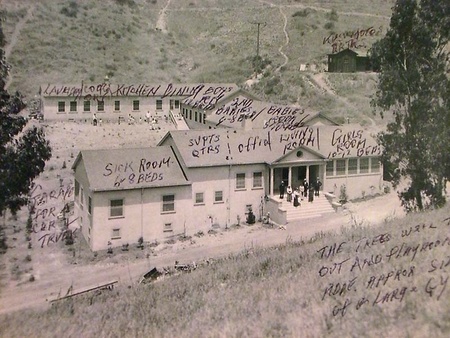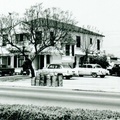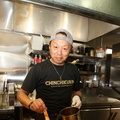Next year, it will have been 95 years since the Japanese Children’s Home of Southern California, called “Shonien,” was built in Los Angeles. Five years from now, it will be one hundred. Even though the facility was closed in 1963, some efforts to preserve its history have started. One of them is the DVD project, which was done by the relatives of Mr. Mits Yamasaki, eighty-four years old, who lived in the facility for ten years between ages 8 to 18.
Shonien was opened in 1914 to house Japanese or Japanese American children whose parents could not take care of them because of financial difficulties. That was the era of the Great Depression which hit almost all the families of the entire world including early time of Japanese immigrants to the United States. Mr. Yamasaki recalls those years and emphasizes “I cannot imagine where I would have been or what I would have been doing if there had not been Shonien.” And also he says passionately but firmly “I want people to know that there was such a person who built the facility, and there were such people who did take care of so many children.”
Mr. Yamasaki’s parents were immigrants from Hiroshima. He had two brothers. His mother passed away in 1931 due to illness. In the meantime, his father got laid off and could not pay the rent. One day he came home from school, the door of the house was locked, so he could not get in. Fortunately the family across the street let him and his brothers stay for several days, then they were taken to Shonien by the effort of a reverend of the church that their mother used to go to. After that their father suddenly disappeared.

Shonien buildings. Mr. Yamasaki wrote notes directly onto the photograph indicating how each space was used. (Photo courtesy of Mr. Yamasaki)
At Shonien, they got up at five forty-five every morning, there were church services at six fifteen and breakfast at six forty-five. There were even number of boys and girls, almost all went to school near the facility. But most of the children went back to their families or relatives after staying for several years when their financial situation improved. So the instances like Mr. Yamasaki who stayed there for ten years were not very common.
There was enough food at Shonien, and they enjoyed lots of games together, so Mr. Yamasaki recalls “The life of Shonien was not so bad.”
The person who built Shonien was Mr. Rokuichi Kusumoto and because of hard efforts like his, they could receive lots of support from the Japanese community. Lots of organizations and businesses donated various foods, goods, and money. Gradually the number of children living at Shonien increased, so they had to build new facility to accommodate them. I don’t have the exact number of how many children stayed at the facility, but I can easily imagine that over the years the number could be several thousands.

Children and faculty of Shonien. Mr. Yamasaki is seated in the second row from the front on the far right. (May 5, 1937) (Photo courtesy of Mr. Yamasaki)
However, when the war between Japan and the US started, they had to close the facility, followed by the evacuation of 120,000 Japanese or Japanese Americans to the concentration camps. Some of the children, whose families came to pick them up, were sent to the camps with their families, but the children whom nobody came to pick up, were sent to the Children’s Village built at Manzanar Camp. There were 38 children.
Mr. Yamasaki, 18 years old at that time, was sent to Rohwer Camp in Arkansas, and the next year he was released, went to Chicago, worked there for a while, and then he joined the US Army in the spring of 1945. He was transferred to a Minnesota base, then Maryland, and to Japan, where he served for a year. In 1947, he came back to the United States, married his wife Mary in 1950, and now he has two sons and four grand children.
He did not have good feelings about his father, because his father did not visit Shonien to see him and his brothers, while a lot of other children had their families visit.
After the war started, he saw his father at the Santa Anita horse track, used for the assembly center for evacuees. His father was to be sent to Poston Camp, Arizona. At that time, he just told his father to send a post card some time.
He did not receive any post cards from his father. Again in Chicago, he saw his father at the hotel he was staying, but his father left the hotel the next day as if he was avoiding him.
Several years passed, and soon after Mr. Yamasaki got married, his wife started to send Christmas cards to her father-in-law. Sometimes, some presents. And she kept sending them until finally, in 1970, Mr. Yamasaki and his father reconciled. His father came from Chicago to visit Mr. Yamasaki’s home in Gardena and stayed there for a week. Since then they would visit each other and kept contact but his father never told Mr. Yamasaki the details about what happened in the past, or why he did not get in contact with Mr. Yamasaki for such a long time. When he died in 1982, so did his thoughts.
Mr. Yamasaki was not alone. There must have been so many cases like this around that time. Of course Shonien was not the reason why it had to happen. The war influenced a lot of the relationships of family members, and we can also say broken relationships were the product of the over all economic situation. But, like Mr. Yamasaki’s father’s story, so many stories end up without being told, and people just have to keep on going with their own lives without knowing what really happened.
With that on my mind, I visited the former site of Shonien in the Silverlake area in Hollywood. This facility was opened in 1920 with 5 big lots of land. That shows how big the support was that they received from the Japanese community. Since the land was sold, some houses have been built on the site.
From the hillside street where Shonien once stood, I could see downtown Los Angeles and I started to think what went through the children’s minds while looking at this view. Suddenly Mr. Yamasaki’s words came back to me, “I want many people to know about Shonien.” I repeated the words in my mind, and then I realized his message. That must be—not to forget the spirit of Shonien which was lost in the midst of economic wellness.

Hollywood hillside street where Shonien once stood. It is currently a residential area with a view of downtown Los Angeles.
*This article in Japanese was originally published in TV Fan in June 2008.
© 2008 Yukikazu Nagashima






